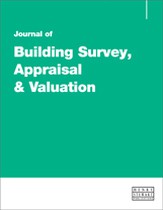Meeting the challenges of structural damp diagnosis in older buildings
Abstract
Diagnosing dampness in the walls of buildings that were constructed 100 years or more ago, often using materials and techniques that are very different from those in use today, can be extremely challenging. Despite the availability of a wide range of diagnostic equipment aimed at identifying building dampness, there is no single piece of diagnostic equipment currently available capable of overcoming the wide natural variations found in the field, that is able to reveal excess moisture within structures, and equally importantly, to determine its severity. All too often, damp in walls is misdiagnosed by over-reliance on a single piece of equipment. This equipment often appears to have been designed on the assumption it will be used on buildings constructed from currently available standard materials, which have been assembled using conventional techniques to meet current regulations. However, when using electronic meters to diagnose damp, if multiple measurements are taken using different types of meter, it is possible to overcome most of the limitations of individual meter types along with any tendency to misrepresent the moisture status of older or less common building materials. This paper outlines a method of damp diagnosis for historic and vernacular walls that allows multiple readings, taken with three complementary meter types, to be combined and mapped back onto the building. This method highlights the differences between raised salts and true excess moisture, together with their respective severities and spreads, leaving the surveyor free to apply his/her knowledge of materials science and building construction to identify the most likely causes of any problems revealed and, if necessary, to devise remedial strategies that are compatible with the building. Three examples illustrate how the method outlined can be successfully used on buildings with very different moisture problems.
The full article is available to subscribers to the journal.
Author's Biography
David M. Kinsey is a self-employed, independent damp consultant, with a particular interest in dampness affecting the structure of historic vernacular buildings. David has backgrounds in both general building surveying and software engineering (primarily tracing and resolving problems that give rise to intermittent failures when the paths between cause and effect are not apparent). The damp consultancy arose from the marriage between these background disciplines in 2011, following David’s realisation that the majority of serious problems affecting older buildings that he was asked to survey were damp-related. Since then, he has sought to improve on traditional damp diagnostic techniques to overcome the inherent difficulties imposed by historic building construction. This has led him to experiment with different diagnostic equipment and seek to reliably combine the positive attributes of the best tools found.
Citation
Kinsey, David M. (2019, December 1). Meeting the challenges of structural damp diagnosis in older buildings. In the Journal of Building Survey, Appraisal & Valuation, Volume 8, Issue 3. https://doi.org/10.69554/ZJWR6960.Publications LLP
